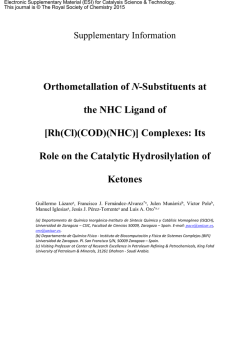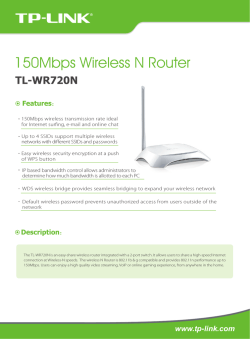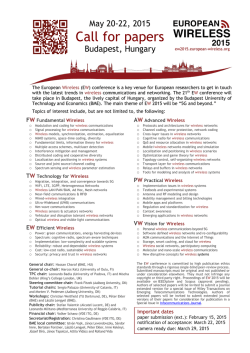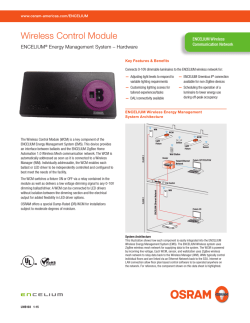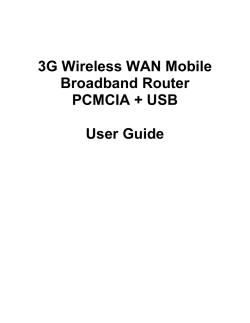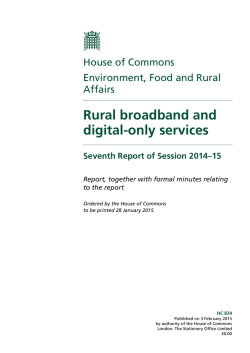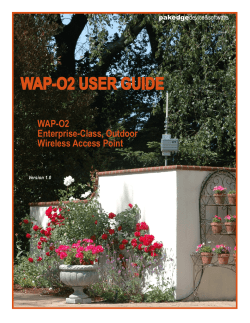
University of Zaragoza, Mobile Communications Group, I3A (Spain)
CALL H2020-DRS-2015: Disaster-resilience: safeguarding and securing society, including adapting to climate change. DRS-6-2015: Crisis management topic 6: Addressing standardisation opportunities in support of increasing disaster resilience (Hacer referencia al topic y objetivo de interés) University of Zaragoza, Mobile Communications Group, I3A (Spain) PREVIOUS EXPERTISE The Mobile Communications Group at the Aragon Institute of Engineering Research (I3A), in University of Zaragoza, has been recognized as a Quality Research Group by the Regional Government of Aragón. The Mobile Communications Group, with a workforce of 9 scientific staff (6 PhD graduates and 3 PHD students), has been working in the Mobile Communication field for more than fifteen years, specifically focused on mission critical communication systems for crisis and disaster management. In this sense, the group has been able to perform conceptual studies (numerous Master Thesis Projects, Ph.D. Theses and several publications in high quality magazines have been produced in this field) and to implement hardware demonstrators based on the use of DSP and ASICs as well as the development of planning tools and applications for TETRA/TEDS, UMTS and LTE. On the conceptual studies point of view, the group has been widely involved in CDMA, TDMA an OFDMA issues concerning layers 1, 2 and 3. We have developed specific simulators for radio communication systems for emergency management applications, especially, but not only, concerning to physical and link layers, which allow to evaluate and to compare various technologies on the physical layer (e.g.: synchronization, channel estimation, equalization, channel coding, amplifier linearization, etc.) and to evaluate different proposals with the aim of matching each traffic model with its corresponding quality-based parameters. In the last case, research includes aspects regarding both link and network levels, involving traffic and capacity characterization and provision of quality of service in packet based wireless systems, cross-layer design of medium access control and radio resource management strategies for cellular and ad hoc, mesh networks (interference management, scheduling, mobility management, admission/access control for multimedia wireless systems, adaptive routing in ad-hoc networks, etc.). POTENTIAL CONTRIBUTIONS TO THE TOPIC Knowledge about advanced mobile broadband wireless technologies for PPDR communication systems: Advanced Heterogeneous Networks (HetNet) based on relay, femto and pico base station solutions; distributed wireless mesh networks and other emerging wireless networks. Knowledge about joint development of efficient radio resource management (RRM) at link and network level for implementing strategies for PPDR broadband communication systems: scheduling, power and rate control and interference management in standard and HetNet deployments. Knowledge about dynamic resource management, mobility management, admission control, selection/reselection of the access node; capacity analysis, and adaptive network configuration for PPDR broadband communication systems. are also considered. Knowledge about cost effective solutions. Energy-efficient communication and cooperation in homogeneous and heterogeneous networks PPDR broadband communication systems. Knowledge about Cognitive Radio for PPDR broadband communication systems, including transceivers design focused on facilitating the sensing and search for available spectrum holes, the control of the operating mode (AMC, FFT mode, etc.) and also the exploration of energy consumption vs. spectrum efficiency trade-offs. Knowledge about interoperability of broadband and narrowband wireless systems for Public Safety. Knowledge about reconfigurable power-efficient wireless transceivers for cognitive radios, including linearization and joint optimization techniques for power amplifiers, multi-/broadband antennas, and design, implementation and verification of adaptive impedance tuning circuits for broadband signals for PPDR broadband communication systems. EXPERIENCE IN RESEARCH PROJECTS The group is involved in several projects at European, National and Regional level, and also by private companies in areas related to PPDR broadband interoperable radio communication systems. In the last five years, our group has been funded with more than 3M€. Projects: CENIT “TelMAX: Wideband Professional Mobile Communication System”, designed a complete wideband mobile communication system for public security and emergency services. FP6 PULSERS Phase II (Pervasive Ultra-wideband Low Spectral Energy Radio Systems PHASE 2), provided benefits to human, intermachine and mixed communication needs. FP7 EUWB (Coexisting Short Range Radio by Advanced Ultra-Wideband Radio Technology), consolidated technical advances in scientific areas related to UWB, such as cognitive signalling, intelligent multiple antenna and multiband/multimode concepts. Teltronic S.A.U. (Spain) PREVIOUS EXPERTISE Since 1974 Teltronic has been devoted to the design and manufacture of radiocommunications equipment (portable, mobile, desktop, onboard, vehicular consoles, etc.) and systems (network infrastructure, control and communication center, video solutions and apps, etc. ) for professional uses with headquarter, R&D center and manufacturing plant located in Zaragoza, with a workforce formed by 300 people (about 150 R&D staff). Since July 2011, Teltronic is part of N+1 Private Equity, one of the major Spanish private investment groups with more than € 3 billion under management. Teltronic is part of Tryo Technologies Group. Teltronic’s main customers are operative in sectors of maximum importance for our society, such as Public Safety and Security, Emergency Services, Transport, Civil Protection, Utilities, Industries (power & water utilities, mining, oil&gas), public and private communications networks operators, etc. (more than 400 projects implemented in 60 countries). Ongoing innovation and the introduction of new technologies are key tools to continue offering forward-looking full integrated solutions for the radiocommunications market under different standards (TETRA, P25, LTE, etc.). Teltronic is member of TETRA Association and P25 Technical Interest Group. As member of TETRA Association, Teltronic has representatives in the Executive Board, Marketing Group, Rail Forum (vice-chairman) and Technical Forum. Teltronic’s quality management system is in line with the requirements established by the UNE-EN-ISO 9001:2008 standard and is certified by an accredited official body. The EFQM model has been adopted as a tool for the evaluation and improvement of management excellence. POTENTIAL CONTRIBUTIONS TO THE TOPIC Whole the following knowledge is based on the large experience in the design, develop and deploy of our products and solutions in real PPDR scenarios (national, regional and incident areas). Knowledge about mobile wireless technologies for PPDR communication systems under TETRA, APCO P25, advanced mixed solutions TETRA-LTE, TEDS and migrations from analog systems to digital ones. Knowledge about interoperability and interconnection concepts intra/inter systems and through different narrowband and broadband technologies and protocols. Knowledge about standard operational procedures, real-time locations and video services used in control and communications centers (besides common voice services in PPDR: very fast call set up, group -push to talk-, encrypted, direct mode communications, etc.). Knowledge about design techniques oriented to system availability (anytime, anywhere), congestion control (access priorities, preemption, etc.) and guarantee of grade of service, Knowledge about design techniques oriented to reliable and suitable devices according to PPDR scenarios. Knowledge about optimization techniques to increase the performance of the communication systems and offered services: management of a synchronous data transmission service over standard TETRA signaling, such as GPS location data sent by TETRA short data service (SDS) messages in LIP format, without negative impact in the rest of asynchronous access services. EXPERIENCE IN RESEARCH PROJECTS Involved in several research projects at European, National and Regional level (PROFIT, CENIT, AVANZA, CDTI-IDI, CELTIC, EUREKA, EUROSTARS) related to broadband interoperable radio communication systems. More than ten contributions in research projects in the last ten years. Most representative according to PPDR scenarios are: 2007: CDTI: PRISE “Privacy and security techs. in communications systems”. 2007: CDTI: MEROFA “Robust communications systems over IP (tolerance against errors)”. 2007-2010: CENIT: TelMAX (www.proyectotelmax.es). “Wideband Professional Mobile Communication System””. 2011-2013: CELTIC AVANZA: SAN “Survivable ad-hoc network for 4G and beyond”. 2012-2014: CDTI INLAP. “LTE Infrastructure for PMR professional users”. PREVIOUS COOPERATION EXPERIENCIES BETWEEN TELTRONIC AND UNIVERSITY OF ZARAGOZA In the field of PPDR communication systems a deep cooperation between TELTRONIC S.A.U. and University of Zaragoza started in 1996. The purpose was to carry out a whole mobile station prototype considering the TETRA system in professional radio communications, allowing the company to grow in the field of digital technologies. Afterwards, a new collaboration to develop a TETRA mobile terminal was made, and following that, the cooperation was towards a multimedia base station and terminals. This was translated into the joint projects “Analysis, design and development of a digital automatic gain control in a mobile TETRA terminal” and “TIMBA: new wideband wireless technologies”. The cooperation between TELTRONIC and the group continued in the projects “Analysis and design of a wideband cellular mobile system with IP transport”, “BANPROX and BANPROX 2: Wideband Communications for Professional Mobile Radio” and “LTE Infrastructure: Radio Transmission Efficiency and Bandwidth Management”, where the research core was related to new wideband wireless technologies focused in wide area networks. It has to be emphasized the CENIT project “TelMAX: Wideband Professional Mobile Communication System”, whose goal was to design a complete wideband mobile communication system for public security and emergency services. Our know-how about the PPDR wireless communication networks and services is also established across works as “Digital wireless communication network design for security and emergency services of the government of Aragon”, and “Design and planning of the TETRA network belonging to the Ebro River Confederation”, funded by the public company of Telematics Services of Aragon and the Ebro River Confederation, respectively. Three patents owned by TELTRONIC and co-authored by the Mobile Communications Group researchers have been submitted as a result of these joint projects. Contact: Teltronic: Alfredo Calderón ([email protected]) University of Zaragoza: Antonio Valdovinos ([email protected])
© Copyright 2024

